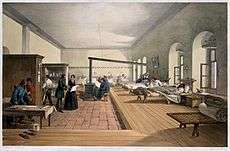Selimiye Barracks
| Selimiye Barracks | |
|---|---|
| Selimiye Kışlası | |
| Harem, Üsküdar, Istanbul, Turkey | |
|
Selimiye Barracks | |
 Selimiye Barracks | |
| Coordinates | 41°0′29″N 29°0′57″E / 41.00806°N 29.01583°E |
| Site history | |
| Built | 1828 |
| Built by | Sultan Mahmud II |
| Battles/wars | Crimean War (1854-1856), |
| Garrison information | |
| Occupants | First Army HQ, Turkish Land Forces |
Selimiye Barracks (Turkish: Selimiye Kışlası), also known as Scutari Barracks, is a Turkish army barracks located in the Üsküdar district on the Asian part of Istanbul, Turkey. It was built first in 1800 by Sultan Selim III for the soldiers of the newly established Nizam-ı Cedid (literally "New Order") in frame of the Ottoman military reform efforts.[1]
Construction
The initially wooden barracks was designed by Krikor Balyan. It was burnt down in 1806 by revolting Janissaries, who were against the reforms. Ordered by Sultan Mahmud II, rebuilding of the barracks in stone began in 1825 and it was completed on February 6, 1828. It is a gigantic rectangle building 200 m × 267 m (656 ft × 876 ft) with a large parade ground in the center. The structure has three floors on three wings and two floors only on the eastern wing due to inclined terrain.[2] During the reign of Sultan Abdülmecid I, the barracks were renovated twice, first in 1842–1843 and again in 1849–1850. During this process, a tower seven stories in height was added to each of the four corners, giving the barracks the look they have today.
Crimean War
During the Crimean War (1854-1856), the barracks were allocated to the British Army, which was on the way from Britain to the Crimea. After the troops of the 33rd and 41st[3] left for the front, the barracks were converted into a temporary military hospital.
On November 4, 1854, Florence Nightingale arrived in Scutari with 37 volunteer nurses. They cared for thousands of wounded and infected soldiers until she returned home in 1857 as a heroine.
Around 6,000 soldiers died in the Selimiye Barracks during the war, mostly as the result of cholera epidemic. The dead were buried at a plot next to the barracks, which became later the Haydarpaşa Cemetery.[4]
Today, the northmost tower of the barracks is a museum.[5]
- Crimean War
 An early photo, taken at Scutari, of officers and men of the 93rd Highland Regiment, shortly before their engagement in the Crimean War, 1854.
An early photo, taken at Scutari, of officers and men of the 93rd Highland Regiment, shortly before their engagement in the Crimean War, 1854. An 1856 lithograph of the Selimiye barracks as a hospital during the Crimean War.
An 1856 lithograph of the Selimiye barracks as a hospital during the Crimean War.
Today
Today, it serves as the headquarters of the First Army of Turkish Land Forces.
Location
Selimiye Barracks is situated in the Harem neighborhood between Üsküdar and Kadıköy, close to the Sea of Marmara. The highway connecting the ferryboat terminal and overland bus terminal to the motorway ![]() Istanbul-Ankara runs close beside the barracks.
Istanbul-Ankara runs close beside the barracks.
References
| Wikimedia Commons has media related to Selimiye Barracks. |
- ↑ Istanbul (Turkish) Being the world's largest barracks of it time, it was where Florence Nightingale laid the foundation for modern nursing during the Crimean war.
- ↑ Istanbul Metropolitan Municipality (Turkish)
- ↑ The Regimental Museum of The Royal Welsh. "The Regimental Museum of The Royal Welsh (Brecon)". rrw.org.uk.
- ↑ Tuncay Yýlmazer. "Çanakkale Savaþlarý Gelibolu, 1.Dünya Savaþý, Çanakkale Savaþlarý, Makaleler, Osmanlý Savaþlarý, Osmanlý, osmanlý, Gerçek Tarih, Gelibolu". geliboluyuanlamak.com.
- ↑ "Tower". florence-nightingale-avenging-angel.co.uk.
.jpg)